Download PDF
Download page Applying Gridded Precipitation to a Non-Georeferenced Project.
Applying Gridded Precipitation to a Non-Georeferenced Project
This tutorial is designed to work with HEC-HMS 4.4 though 4.6.1. After HEC-HMS version 4.6.1, the *.mod file should no longer be used. Instead, use the structured discretization method - Applying Gridded Precipitation to a Non-Georeferenced Project - Structured Discretization.
 Initial_Gridded_Precip.zip
Initial_Gridded_Precip.zip Final_Gridded_Precip.zip
Final_Gridded_Precip.zip
There are existing HEC-HMS models that can be updated and improved to utilize gridded precipitation and hydrologic methods. Many of these existing models are not georeferenced with coordinate system or projection information. These models often do not have background maps of the subbasins and reaches. When background maps of the subbasins and reaches are available the coordinate system information is often missing. These older models often use the lump approach for representing subbasins and hydrologic methods rather than the more useful gridded models, which allows the watershed to be represented in greater detail spatially.
In order to use gridded precipitation in the meteorological model and hydrologic methods in the basin model, the user must first georeference the basin model. When converting a lumped basin into a gridded basin, the user needs to process the terrain data for flow directions, and then generate a grid cell file. The grid cell file specifies which grid cells are in each subbasin and the properties of each cell including location, area within the subbasin, and distance to the subbasin outlet. The user can then refer to the grid cell file and create a grid region as a model component. The user then must specify the default grid region to be used in the basin model.
This tutorial is designed to help the user of HEC-HMS learn how to apply a gridded precipitation dataset to a non-georeferenced project.
Overview
In this tutorial, you will perform five tasks to georeference existing subbasin and reach elements before generating a grid cell file and creating a grid region: 1) georeference the project, 2) process terrain information to create a flow direction grid, 3) generate grid cell file; 4) create grid region; and 5) create links in an HEC-HMS basin model.
Background
The Punxsutawney Watershed (400 km2) is part of the Allegheny River Basin located in western Pennsylvania, USA. Primary conveyance streams include: Stump Creek; East Branch Mahoning Creek; and Mahoning Creek. The confluence of Stump Creek and East Branch Mahoning Creek is located east of the enclave of Big Run. Mahoning Creek is downstream of the confluence.
A map of the watershed is shown below.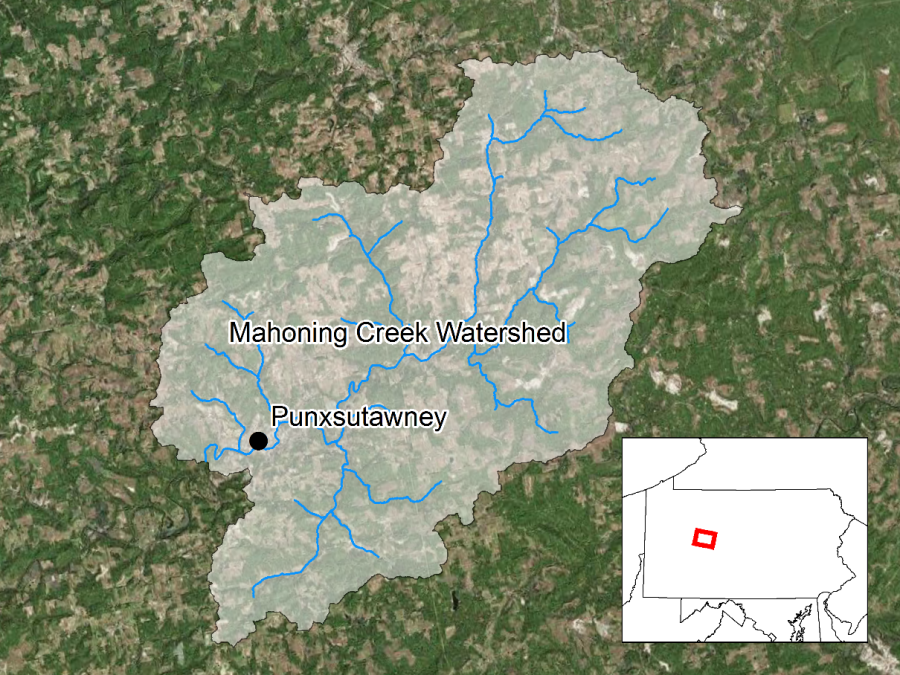
Task 1: Import and Georeference Subbasin and Reach Elements
The basin model was originally defined by delineating subbasins and river reaches using non-GIS tools, therefore, the basin model elements were not georeferenced. Starting with HEC-HMS version 4.3, there are tools to georeference existing subbasin and reach elements using the geospatial information in shapefiles.
The user can import subbasin and reach elements from shapefiles, or georeference existing HEC-HMS subbasin and reach elements. HEC-HMS uses the name attribute within the subbasin and reach shapefiles when importing information from shapefiles. The following steps shows how to georeference existing subbasin and reach elements.
- Double click the HEC-HMS icon to start the program. The main program window will appear.
- To open an existing project, click File and select Open….
- The Open an Existing Project window will open; click Browse to open the Select Project File window.
- Navigate to the project directory and select the Gridded Basin.hms file.
- Click the Select button and the existing project will open as shown below. Notice the basin model is not georeferenced because the elements are displayed as icons.
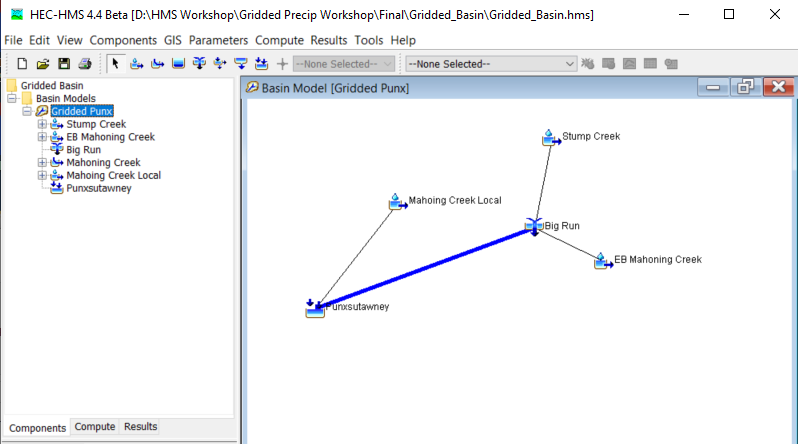
- The subbasin delineation is shown below. Subbasin and reach shapefiles have been created that contains an attribute with names that match the element names in the HEC-HMS basin model.
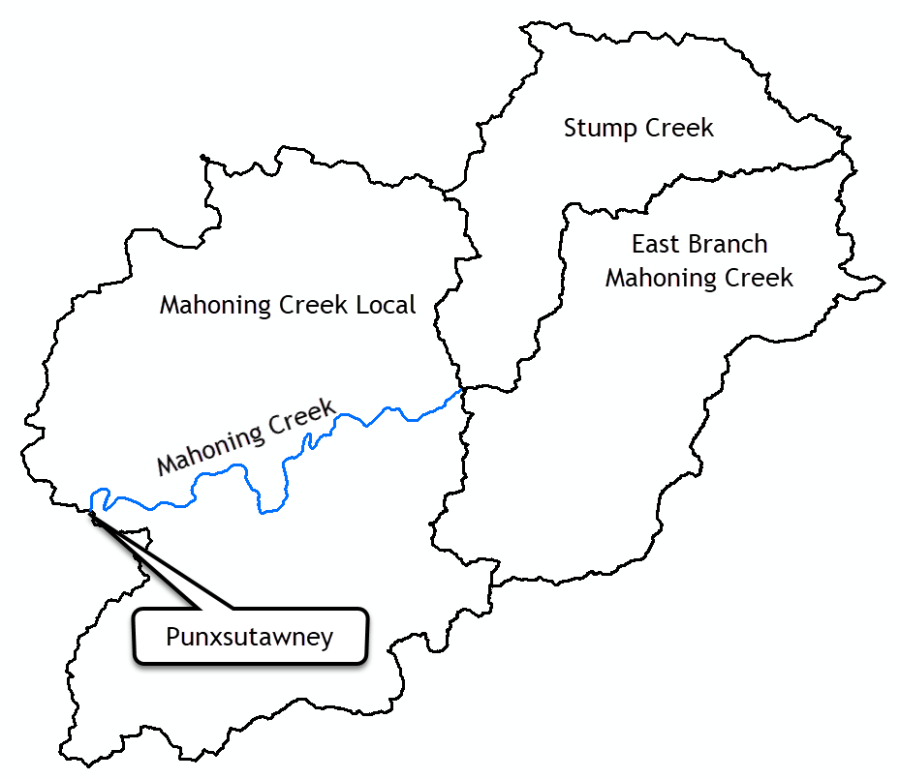
- Go to the GIS menu and choose the Georeference Existing Elements menu option.
- Choose the Subbasins element type and click the Next button.
- Navigate to the … \Gridded_Basin\maps directory and select the Basin Punx.shp file. Click Select. Click Next.
- Choose the Name attribute field to set the subbasin element names. Click the Finish button.
- On the Coordinate System dialogue box, Click Select….
- Click Browse, Select the Basin Punx.prj file. Click Select Click Set. The coordinate system information should populate as shown below.
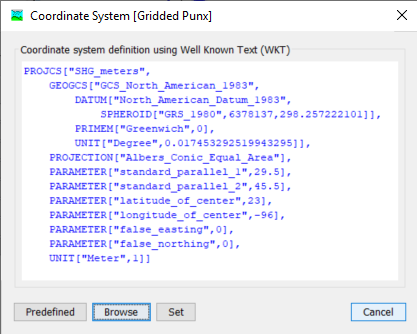
- Follow the previous steps and import the reach feature in the Reach Punx.shp file. The figure below shows the three subbasin elements and the one reach element that were imported from the two shapefiles.
- Right click on the Gridded Punx basin model name in the Watershed Explorer and choose the Resort Elements Hydrologically menu option. The elements in the Watershed Explorer should be ordered from upstream to downstream, as shown below.
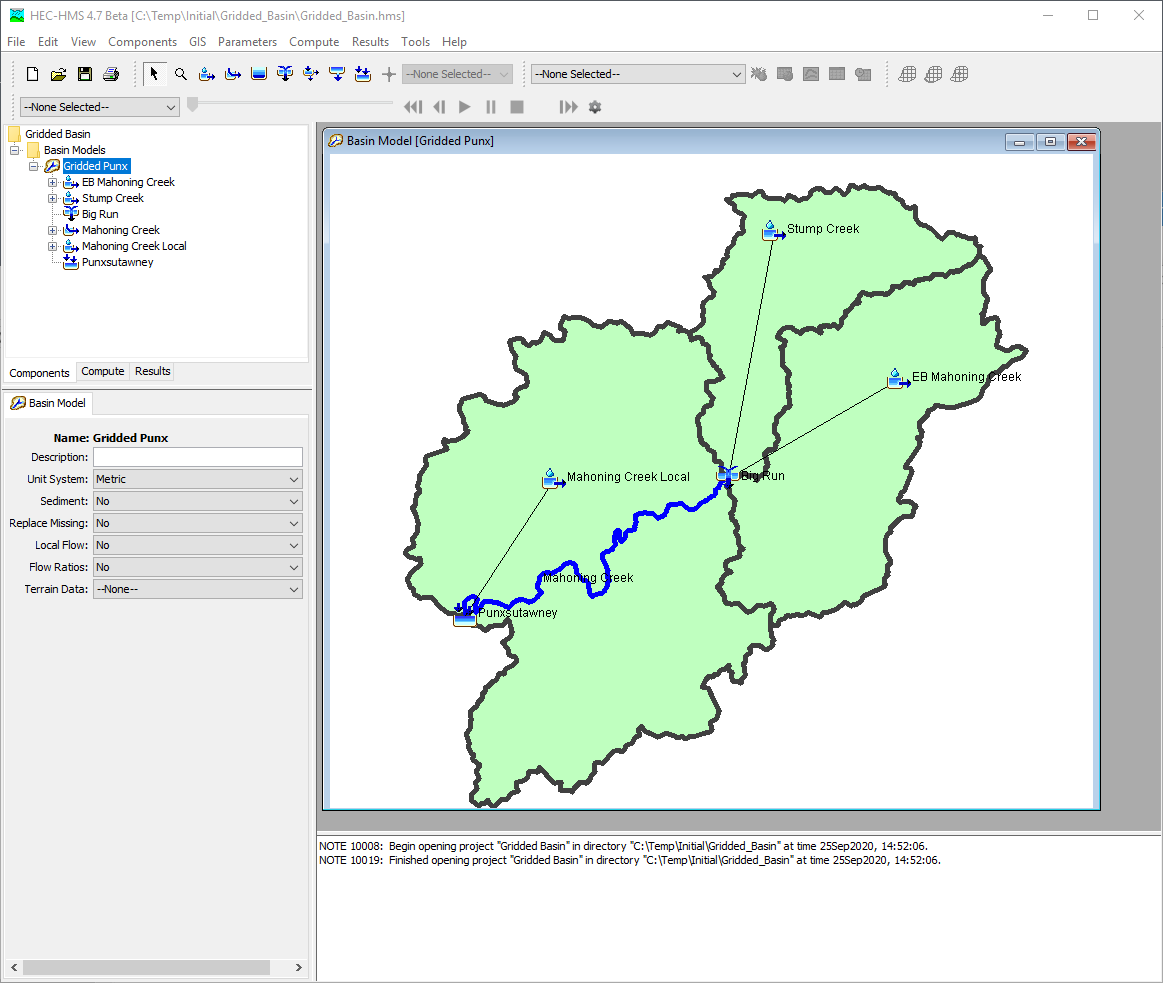
Task 2: Load Terrain Dataset and Run the Preprocessing Steps
- Go to the Components menu and choose the Create Component menu option as shown below.
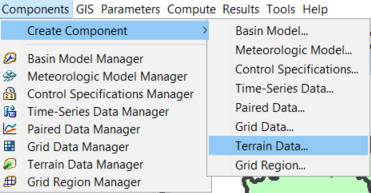
- Select Terrain Data, enter a Name of "Terrain Punx". Click Next as shown below.
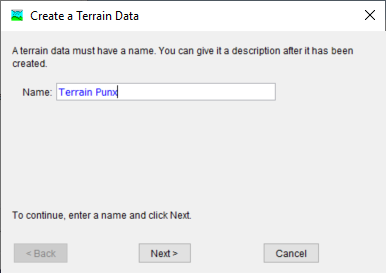
- Navigate to the … \Gridded_Basin\terrain directory and select the file named NED_10m_alb_m_clip.tif. Click Finish as shown below.
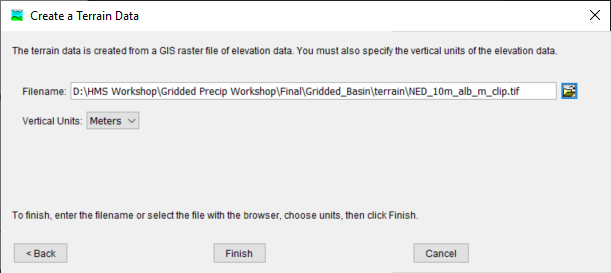
- After the terrain data has been added to the project, it can be associated to a basin model. Open the Gridded Punx basin model's Component Editor and then select Terrain Punx for the Terrain Data as shown in the two figures below. The terrain's coordinate system is read automatically from the Terrain Punx.tfw file.
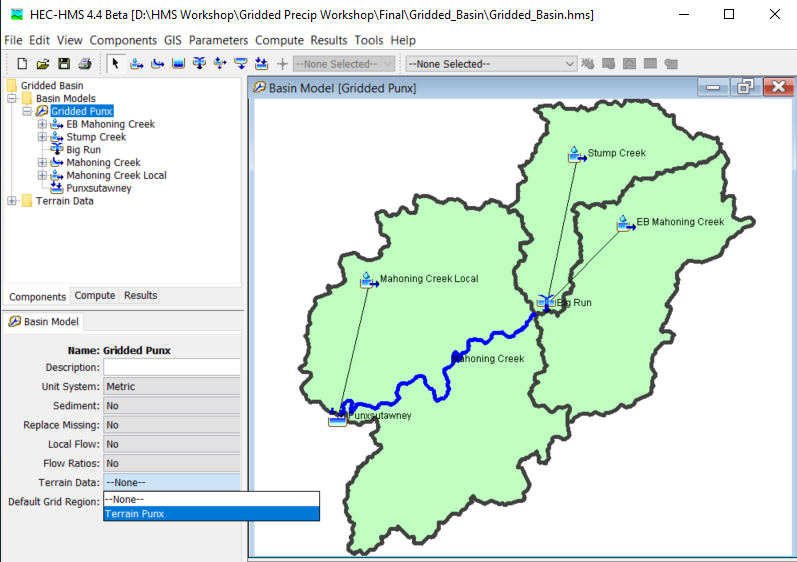
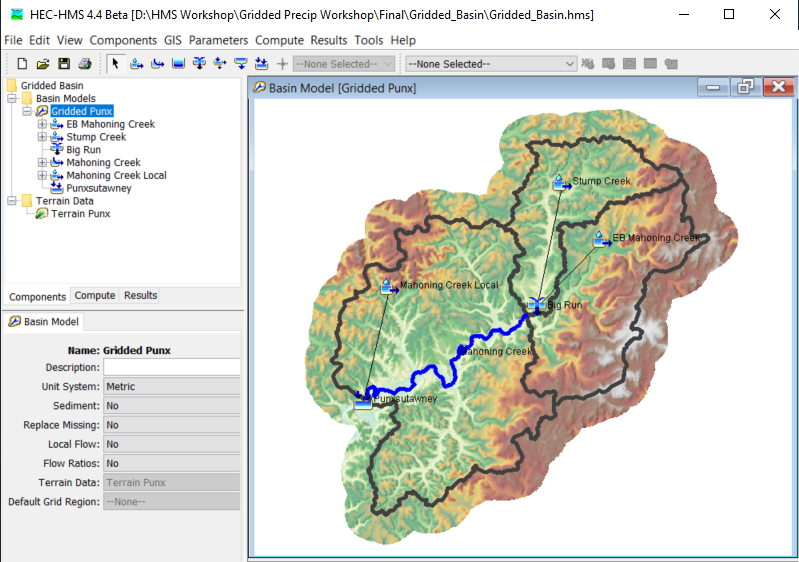
- Select Terrain Data, enter a Name of "Terrain Punx". Click Next as shown below.
- The purpose of the next few steps is to perform drainage analysis on the terrain and produce a flow direction grid that will be needed later to create the grid cell file. Terrain data is a gridded representation of the watershed surface with elevation for each grid cell. This Preprocess Sinks step fills the sinks or depressions in the terrain so that the drainage analysis is possible. Go to the GIS Menu and choose the Preprocess Sinks menu option as shown below. The result of this step is a terrain without depressions, and a Sink Fill raster, as shown in the second figure below.
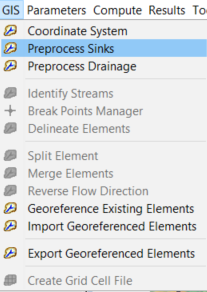
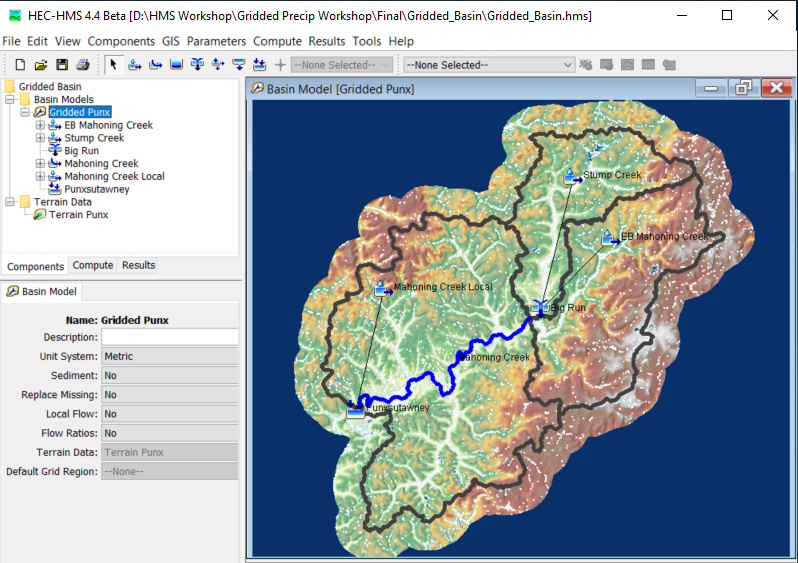
- Using the Sink Fill data from the previous step, the Preprocess Drainage step performs drainage analysis and produces the flow direction and flow accumulation data. Go to the GIS Menu and choose the Preprocess Drainage menu option as shown below.
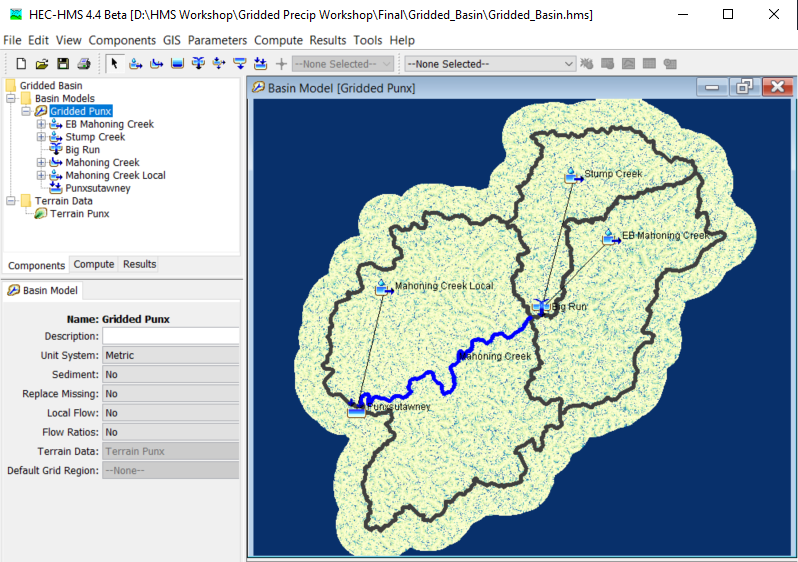
- This optional step shows how to turn off the visibility of map layers to speed up the map display. Go to the View Menu and choose Map Layers in the menu option. Uncheck the visibility for the Flow Accumulation, Flow Direction, Sink Locations, and Sink Fill layers as shown below.
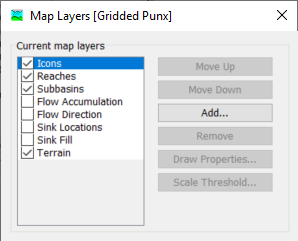
Task 3: Run the Grid Cell Processing Step
- The grid cell file specifies which grid cells are in each subbasin and the properties of each cell including location, area within the subbasin, and the distance to the subbasin outlet. The cell location and area are computed from the intersection of subbasin polygons and the chosen grid coordinate system like Standard Hydrologic Grid (SHG). The average travel length distance from locations within the cell to the subbasin outlet is computed from the flow direction data set. The Create Grid Cell File tool uses the flow direction data as an input to create the grid cell file. Go to the GIS Menu and choose Create Grid Cell File in the menu option as shown below.
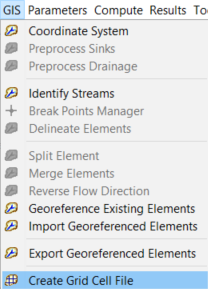
- On the Create a Grid Cell File dialogue box, select a Projection of SHG and Cell Size (M) of 2000 (meters). Click Next as shown below.
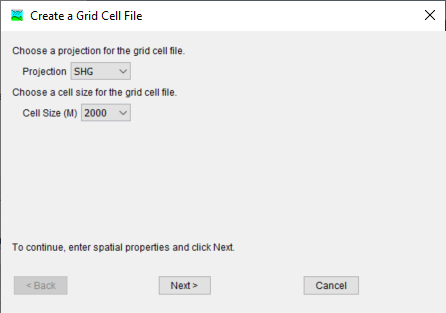
- Select a file location and name. In this example, a grid cell file will be created in the directory ...\Gridded_Basin\regions and it will be named Gridded_Punx.mod. Click Finish as shown below.
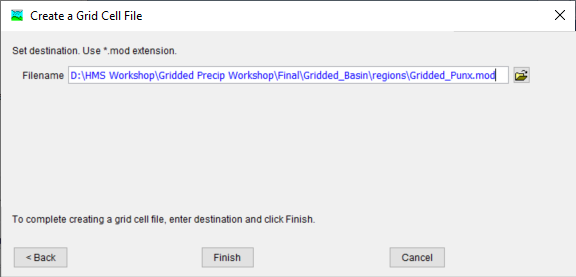
- Navigate to the \Gridded_Basin\regions\... directory and open the grid cell file Gridded_Punx.mod with a text editor as shown below. On the first line of the grid cell file, the Parameter Order will show the order of the data for each grid cell in a subbasin. The parameter Xcoord and Ycoord are the X and Y coordinate of the cell in the SHG grid coordinate system. The parameter TravelLength (km) is the average travel length distance from the grid cell to the subbasin outlet. The parameter Area (sq.km.) is the area of the cell within the subbasin. An area of 4.0 sq.km. is computed when the whole cell is within the subbasin. An area less than 4.0 sq.km. is computed when the cell is on the subbasin boundary.
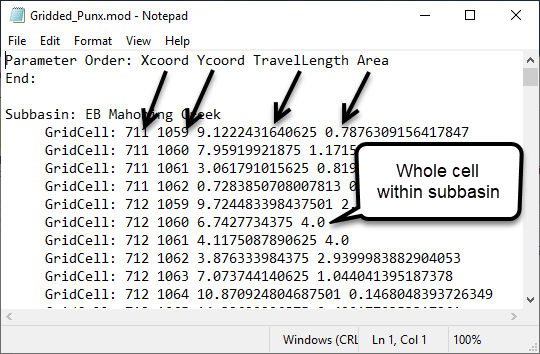
- HEC-Vortex has many utilities and can be downloaded from link https://github.com/HydrologicEngineeringCenter/Vortex/releases. The utility named travel-length-grid-cells-exporter is used to convert the grid cell text file into a shapefile showing the grid cells. By providing the grid cell text file (Gridded_Punx.mod), projection file (Basin Punx.prj), and cell size (2000), as input into the utility, a grid cell shapefile (…\Gridded_Basin\maps\Grid_Cell.shp), is produced as an output. The grid cell shapefile is added as a map overlay showing the gridded representation of the subbasin as shown below.
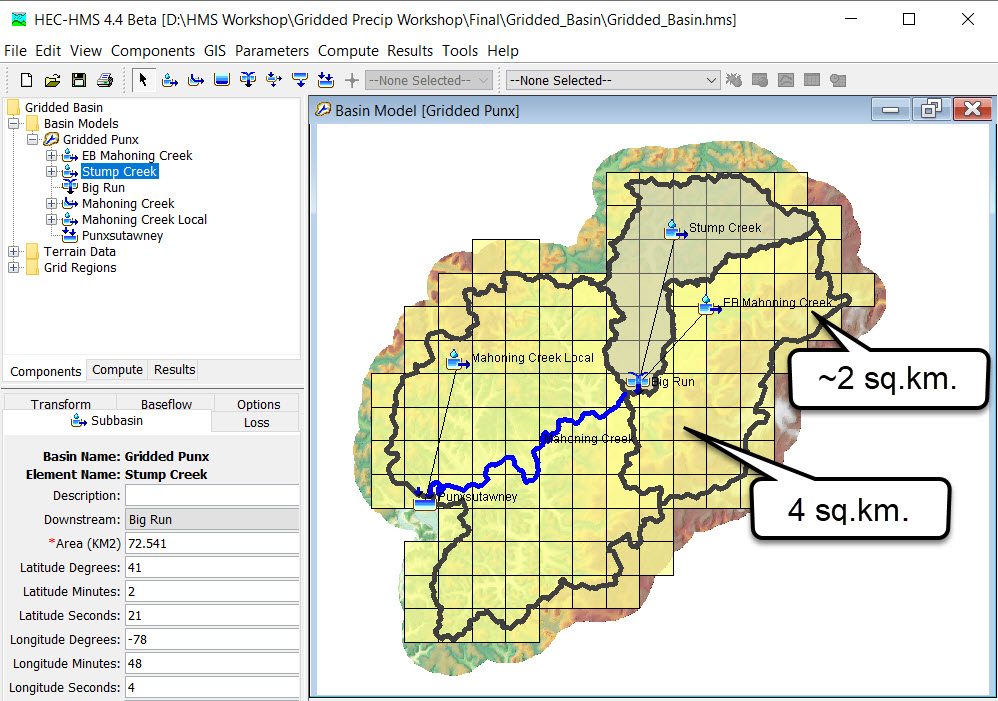
- On the Create a Grid Cell File dialogue box, select a Projection of SHG and Cell Size (M) of 2000 (meters). Click Next as shown below.
Task 4: Import the Grid Cell File as a Grid Region
- This Grid Region step uses the grid cell text file an input to create the grid region as a main component. Go to the Components > Create Component menu and choose Grid Region... as shown below.
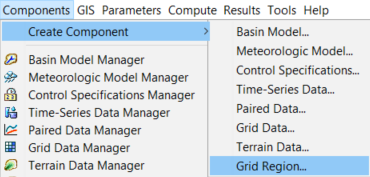
- On the Create a Grid Region dialogue box, enter a Name of Grid Region PunxSHG. Click Next as shown below.
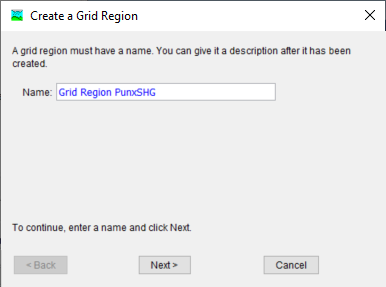
- On the Create a Grid Region dialogue box, navigate to the ...\Gridded_Basin\regions directory and select the Gridded_Punx.mod file. Click Next as shown below. The Grid Region will be added to the Watershed Explorer as shown in the second figure.
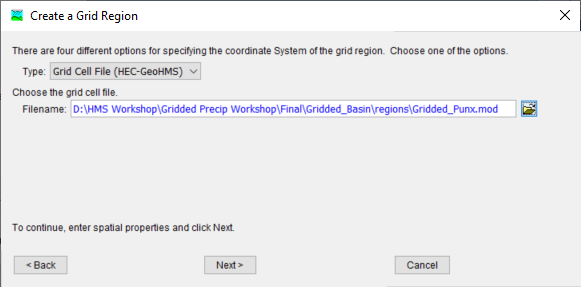
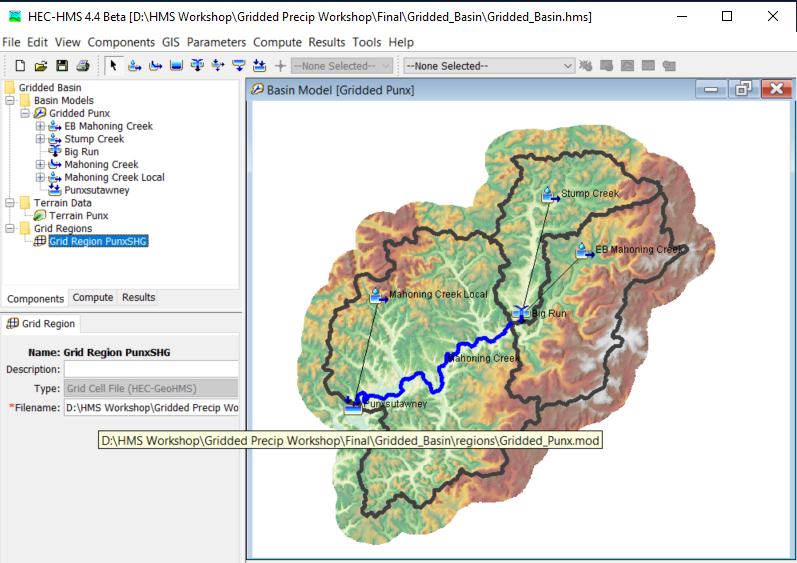
- On the Create a Grid Region dialogue box, enter a Name of Grid Region PunxSHG. Click Next as shown below.
Task 5: Link the Grid Region to the Basin Model
- Select basin model Gridded Punx. Within the Component Editor, select the Grid Region PunxSHG as the default grid region as shown below. Now, gridded precipitation can be applied to the basin model. If the ModClark transform option is selected, then the program will allow the modeler to choose a separate grid region for each subbasin.
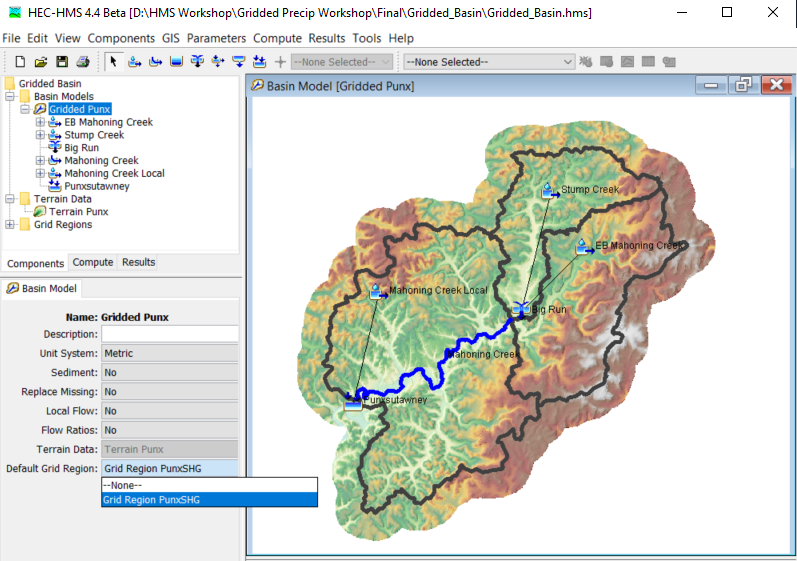
In case of changes to the subbasin name or subbasin delineation, the user must rerun the grid cell file step and override the previously created grid cell text file. Also, if the gridded precipitation is in a different grid projection, or the cell size does not match the cell size in the grid cell file, then a new grid cell file would need to be created, or the gridded precipitation data would need to be modified.